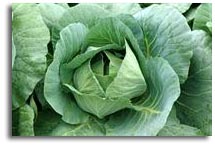If you hope to do
well with your fall garden, you really should have a suitable plan. Thatís
the advice from LSU
AgCenter horticulturist Dr. Tom Koske.
"In the fall, we go from too hot to too cold," Koske says, but adds, "Too
cold isnít all that bad unless thereís an early killing frost." Overall,
though, he says fall garden preparation is similar to spring planting.
|

Cabbage seeds are among the vegetables you can plant for a fall garden.
Related cole crop seed options are mustard, collards, cauliflower, brussels
sprouts and broccoli. |
Within the limits of heat and frost, timing becomes critical. Some
fall crops, like tomatoes and bell peppers, should be planted before
August, because they need to get some size before a frost hits. Other
plants, like pumpkins and watermelons, should be planted early,
because they take a long time to grow.
Many of these cold-sensitive crops slow down with shorter days and
cooler nights, making fall fruiting a lot different than fruiting in
late spring or early summer. Thereís less production potential
compared to warm-loving crops. The heat of late summer often causes
poor pollination on mature plants, and thus delays fruit set.
Fall is also a drier period unless we have hurricane rains. It is
still hot and usually dry in August and September, so we will need to
pay more attention to the soil moisture. Water as needed for the
season, because the fall growing season is short enough as it is, and
we canít afford to lose good growth because of low moisture.
Koske highly recommends mulching to conserve moisture.
Fall marks the end of the general growing season, the period when
insect pest populations were growing, too. Many insect populations
are at their seasonal peak before frost. Caterpillars give us fits
with corn and leafy crops at this time. Stinkbugs and various other
bugs and beetles are mature, tough-skinned and hungry. Extra pest
control and special vigilance is usually necessary. Fall is
especially challenging for organic and non-pesticide gardeners.
Soil fertility needs to be considered. Koske says itís common to
practice crop rotation by replacing one crop with another to help
suppress common soil pests.
If a heavy feeder is followed by a light feeder like peas or beans,
there may well be residual fertility, which could result in a bushy
plant with little or no fruit. On the other hand, if a heavy feeder
follows a light feeding crop, you will need to apply a complete
fertilizer before planting.
Since timing is so important with the fall crop, choose crops that
will produce well within this short time. Look for fast-maturing or
bush-type cultivars to ensure a good yield.
Crops to seed in August include turnips, sweet corn, summer squash,
southern peas, mustard, Irish potatoes, cucumber, collards, Chinese
cabbage, cauliflower, cabbage, brussels sprouts, broccoli, beets,
bush snap beans and bush butter beans.
Cauliflower and green shallots can be transplanted in August. North
Louisiana can seed head lettuce and transplant broccoli and brussels
sprouts.
"Some forethought and strategy applied to the fall vegetable garden
will give you a better chance for success in this challenging
season," Koske says.
More information on lawn care is available at your local LSU AgCenter
office. In addition, look for lawn & gardening and Get It Growing
links in the LSU AgCenter Web site:
www.lsuagcenter.com.
|